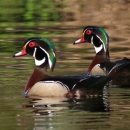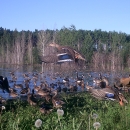NAWCA Small Grants are competitive, matching grants that supports public-private partnerships carrying out projects in the U.S. that involve long-term protection, restoration, and/or enhancement of wetlands and associated uplands habitats for the benefit of all wetlands-associated migratory birds.
Get Started
U.S. Small Grants Application
Advance Planning
The Small Grants Program application process, while simpler than the Standard Grants application process, still takes time and effort, so please plan accordingly and do not hesitate to contact us for assistance.
Before you write the proposal, think carefully about how you will implement your project.
The Basics
- Grant request may not exceed $250,000.
- Partners must match their grant request at no less than a 1-to-1 ratio. For example, applicants requesting a $250,000 grant would also need to contribute at least $250,000 in partner funds (from nonfederal sources) towards the project. Funds that pass through a nonfederal partner but originate from the Federal government are not eligible as match.
- All eligible costs must be directly linked to eligible acquired, restored, or established acres that are completed DURING the project period. This means that each grant and match dollar, except for indirect costs, must be linked to an acre acquired, restored, and/or enhanced.
- In general, laws and requirements that apply to activities funded with NAWCA dollars also apply to items either funded with match dollars or provided as in-kind match (i.e. real property interests). There are very few differences in grant and match for grant administration purposes.
- Grantees are held accountable for both acres and match, as defined in the proposal (as revised) and grant agreement. Without prior approval, accomplishing less than 100 percent of acres or match will result in a reduction of the award amount. This means that you may have to return grant funds if, for example, you do not acquire all the acres you propose to buy, even with match dollars.
- Proposals must be for on-the-ground projects.
- Proposals that keep grant costs not directly associated with acquisition, restoration, enhancement or establishment activities (e.g., grant administration, overhead, indirect costs) below 20% of the grant request are generally more competitive. As an exception, if your organization has an officially negotiated indirect cost rate agreement with a US federal agency, you may use your negotiated rate even when it exceeds 20%. However, having a cost that is lower than the negotiated rate may make your proposal more competitive.
Land-Acquisition Projects
If funded, projects that include real property acquisition must provide a legal recordable document (Notice of Grant Agreement or Notice of Property Restriction) that provides protection in perpetuity to the partnership investments.
Land-Acquisition Documentation
It is important that applicants with land acquisition proposals review the requirements for real property acquisition assistance stated in the Grant Administration Standards document below. You will have to submit all the required documentation at specified times.
Small Enhancement and Restoration Projects On Private Lands
Applicants of proposals selected for funding that includes enhancement and restoration activities are required to guarantee the results of the project for a period of at least 25 years, unless a shorter period is justified.
Before Getting Started
We strongly recommend that early in the proposal development process you contact the coordinator of the Joint Venture region in which your project is located. They can provide you with guidance on developing your project and proposal. Such guidance will improve proposal quality, and allows the Joint Venture Coordinators to understand your project. The Joint Venture Coordinators' prioritization of Small Grants Program proposals from their geographic region is an important element in the selection process.
A map of Joint Venture Administrative Areas can be found in Appendix F of the Proposal Instructions.
Preparing a Proposal
Review the following files and guidelines to prepare your proposal:
Proposal Instructions
Required information and proposal format with examples.
Eligibility Criteria & Processes
Describes eligibility and cost principles that all U.S. NAWCA and Small Grants proposals must comply with. Pay close attention to the timeframes during which both grant and matching funds are eligible.
Word Proposal Outline
Provides “fill-in-the-blank” proposal outlines.
Table Template
Provides “fill-in-the-blank” proposal tables.
Grant Administration Standards and Assistance Award
Describes policies, procedures and example of the one-page grant agreement for approved projects.
Submitting a Proposal
Step 1 - Review Proposal Instructions
Step 2 - Submit Proposal Through GrantSolutions (GrantSolutions Instructions)
Step 3 - Email a Copy of Final Narrative Proposal to your Joint Venture Coordinator
Receipt Confirmation - You should receive an email confirming receipt of your proposal within one week of the deadline. If you do not receive a confirmation, contact one of the Small Grants Program Coordinators immediately. Late proposals will not be accepted.
Final project selections will be made by the North American Wetlands Conservation Council at its meeting in February.
For more information or questions about NAWCA U.S. Small Grants, email: nawca_smallgrant@fws.gov

